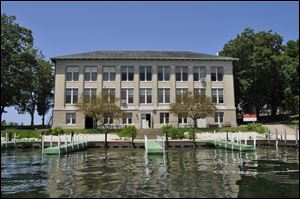
STONE LAB
Algae forecast detailed at Stone Lab gathering
Scientists: 2014 season won’t be as bad as 2011
8/19/2014
Ohio State University's Stone Lab on Gibraltar Island in Lake Erie.
GIBRALTAR ISLAND, Ohio — Scientists expect the remainder of Lake Erie’s algae season to be bad, though not nearly as bad as the worst season on record, 2011.
Rick Stumpf, a federal oceanographer who leads the Lake Erie satellite research and predictive modeling program at NOAA’s National Centers for Coastal Ocean Science in Maryland, said that after re-examining broader rainfall, runoff, atmospheric data, and satellite imagery, he has no reasons to waver from the agency’s July 10 prediction.
RELATED:
■ Mayor says water crisis is similar to 9/11
■ Henry calls water crisis life-changing
■ Sylvania to mull water options
The lake’s 2014 algae season — while significant — will fall well short of the 2011 record algal bloom.
Things could change, though. The bloom, which is highly dependent on wind and weather conditions, is not expected to peak until late September, he said.
But he said there’s no reason to believe that Toledo’s high-profile algae struggles, literally days after the algae season began, should be interpreted as a precursor of what’s to come.
It could have been simply a stroke of bad luck, what Mr. Stumpf and others described as a “highly localized” event because of how the algae bunched up around the Toledo intake crib because of the convergence of wind and wave action the first weekend of August.
Scientists last year found July rain and runoff to be a greater contributor to algae than previously thought. They usually focus on the rain and runoff between March 1 and June 30. But this July’s precipitation was average, Mr. Stumpf said.
That and the heat has been at or below normal since mid-July leads officials to believe the bloom won’t get out of hand, he said.
NOAA this year unveiled a 1-through-10 gradient scale to help people better understand the agency’s annual forecasts, which are still in their early stages.
The 2011 record outbreak is considered a 10. The 2014 forecast calls for a 6, maybe a 7.
Mr. Stumpf discussed the algae forecast at Ohio State’s Stone Laboratory, where about 30 journalists and academic researchers gathered on Monday for a two-day writers workshop.
Laura Johnson, a research scientist at Heidelberg University’s National Center for Water Quality Research in Tiffin, said the Maumee River watershed is highly susceptible to agricultural runoff because 73 percent of the land in it is agriculture.
“Loading in the spring is driving harmful algal blooms,” she said. “The bloom in Toledo was very localized. It’s kind of like what happened in 2013 with [Ottawa County’s] Carroll Township. A lot depends on how winds blow and waves act.”
Justin Chaffin of Ohio State University, the lab’s research coordinator, also discussed discoveries scientists there have made regarding the small but deadly family of toxic algae in the Great Lakes.
The notorious big three of Great Lakes cyanobacteria are known by scientists as “Annie,” short for anabaena, “Fannie,” short for aphanizomenon, and “Mike,” short for microcystis.
Mr. Chaffin also described another buoyant version of anabaena given the scientific name of dolichospermum by taxonomists in 2009 to distinguish it from the heavier version of anabaena that spends most of its life on the bottom of the lakes. They call it “Dolly.”
Even toxic algae that scientists believe has been on Earth for more than 3 billion of the planet’s 4.5 billion years and in the Great Lakes since they were formed 10,000 to 15,000 years ago can be subdivided and renamed.
Another bit of algae trivia: There are more than 100 forms of algae in Lake Erie, most of them good for the food chain, Mr. Chaffin said.
“Lake Erie produces the most fish of all of the Great Lakes because it has the most algae," Mr. Chaffin said, a reference to how healthy algae forms a basis of the food web.
There are more than 80 varieties of microcystis, the main algae that produces toxic microcystin, Mr. Chaffin said.
NOAA, in conjunction with its Great Lakes Environmental Research Laboratory in Ann Arbor, is publishing short-term algae forecasts online twice a week now because of Toledo’s Aug. 2-4 water emergency. It had been doing them once a week.
The agency also expects more precision in satellite imaging for Toledo and other western Lake Erie shoreline communities once a new European Space Agency satellite is launched in 2015.
Depending on the timing, the images may not be available until the 2016 season, though, Mr. Stumpf said.
NOAA has a cooperative agreement with the European Space Agency and believes the high-resolution images will yield more information than the moderate resolution images now coming from a NASA satellite, he said.
“I can’t emphasis enough once we go to higher resolution we should be better able to help places like Toledo,” he said.
In a follow-up email after his presentation, Mr. Stumpf told The Blade the new satellite technology should help Lake Erie shoreline communities have more time to prepare for an algal onslaught.
The former European Space Agency satellite had a communications failure in April, 2012, leaving NOAA without as much capability until its new OLCI, short for ocean land color imager, is in space.
It will be on the ESA’s Sentinel-3 satellite that launches next year, Mr. Stumpf said. It will filter out sunlight that casts a glare on images with 10 times as many pixels for sharper images, he said. In 2017 or 2018, the ESA will launch a second Sentinel-3 satellite.
“So by 2018, we will have daily coverage [of high-resolution satellite images of western Lake Erie algae],” Mr.Stumpf said. “That means we can see the small patches of bloom that develop.”
He said the newer technology “should show us data up to one-quarter mile from shore.”
Contact Tom Henry at: thenry@theblade.com, 419-724-6079, or via Twitter @ecowriterohio.